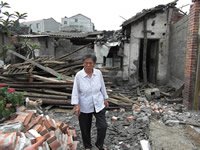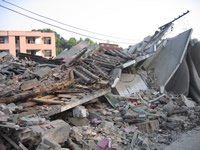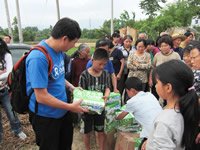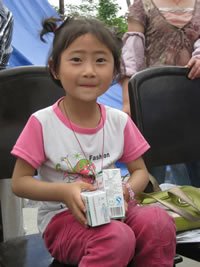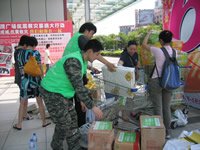Text by Keith Wong, on 21 May 2008
In the town of Xiushui, in Sichuan, hardly a building remains standing after the earthquake, and almost all of the survivors are homeless.
This woman (right) stays with about 50 other people in a makeshift tent erected next to the pile of rubble which once was her house. Her husband remains missing.
Her tent is made of a plastic woven fabric commonly called "red-white-blue" - named after the colours of the rain-resistant material. Formally, it is called polyethylene or polypropylene.
The fabric was specifically requested by the residents. They want the flexibility of how to use it - as ground cover, for shelter, and to be able to easily adjust the size of the area to be covered.
A typical temporary shelter made with the red-white-blue. For people's immediate needs, they have requested this fabric for its versatility in use.
Yet, the red-white-blue home can only be a temporary measure. The material is not strong enough to endure the rainy season and its typhoons: the rains are due to start in June and run until September or so. In Xiushui, it has already been raining for several days straight.
The supply of stronger tents is extremely limited in Sichuan. According to official figures, only about 280,000 tents have been delivered to affected areas so far. The government has just announced, and has sought Oxfam's support, to supply one million temporary pre-fabricated shelters, but this will takes many weeks. Overseas shipments of about 150,000 donated tents are on the way from outside Mainland China.
Oxfam Hong Kong is sourcing tents from Gansu, just north of Sichuan, from Hebei to the northwest, and from other locations. But it may take two weeks or more to receive the bulk order, and in the meantime, the red-white-blue is meeting people's immediate needs for shelter.
In addition to the red-white-blue material, Oxfam Hong Kong has also delivered packaged milk to people in Xiushui, with a priority for children, women and the elderly - families with these members received the supplies first.
The milk can help people endure the temperature changes in Sichuan: in the daytime, it is about 25 to 30 degrees Celsius, and many men go about shirtless. At night, it drops to about 15 degrees.
People in Xiushui have shown a strong resilience in the face of the crisis. They are cooking outdoors, even though flies surround her food and utensils. To feed their surviving livestock, they have searched through the rubble to find maize. The poultry will be their meals in the future.
Oxfam Hong Kong has almost 20 staff members in the disaster zone. Working alongside government units, local NGOs and a disease control centre, we are focusing on shelter, water and sanitation, and prioritising the needs of women, children, elderly people, people in remote areas, and people with specific needs. For instance, we are supplying sanitary pads for women; nutritious milk for children and elderly; and Halal food and milk to five remote Hui (Muslim) communities.
For a map of Oxfam's work: http://www.oxfam.org.hk/sichuan_earthquake/en
For more photos: /en/photos-and-videos
For a book (published in Chinese) about Oxfam Hong Kong's disaster management experience, please visit here.
OXFAM in CHINA: Oxfam Hong Kong has been working in the country since 1987. Last year, Oxfam allocated over HK$68 million (over USD8.7 million) on about 230 development and emergency projects in Mainland China.
OXFAM in an EMERGENCY: Oxfam Hong Kong, founded in 1976, has responded to hundreds of disasters over the years, including the 1984 famine in Ethiopia, the ongoing crisis in Sudan, and the Asian tsunami. In any crisis, 100% of all donations received go to assist the survivors.
Keith Wong, at the disaster site in Sichuan, is a member of the communications team of Oxfam Hong Kong.

